
|
|
Abstract:
Bahá'í activities in Korea 1921-1988.
|
All chapters
PrefaceShoghi Effendi's monumental world-embracing spiritual crusade, commencing in 1953, was destined to take the Bahá'í Faith to all the remaining countries and island sovereignties which the Faith of Bahá'u'lláh had not yet reached. The Ten Year Crusade, as it was called, ended in success and coincided with the first World Congress in London in 1963. During the Ten Year Crusade the Guardian assigned certain areas of the world to the then-existing National Spiritual Assemblies. The Assemblies were to supply the areas with pioneers and to give whatever assistance was needed to establish the Faith.Korea was assigned to the National Spiritual Assembly of the Bahá'is of the United States as a consolidation goal. In 1953 Korea already had some resident Bahá'ís but the Faith was a long way from being firmly established. The first resident Bahá'ís in that difficult post-war period were young men in the United States Armed Forces. Due to the dedication and determination of those young men, who were praised by the Guardian, the Faith became established with Koreans declaring their belief in Bahá'u'lláh. The title of this book is taken from words written by 'Abdu'l-Bahá in a Tablet to Miss Agnes Alexander shortly before His passing. He hoped that "in Korea thou wilt raise the banner of the Greatest Guidance." We must express our deep appreciation to Hand of the Cause Miss Agnes B. Alexander for her carefully preserved documents, papers, letters, etc. Much of the material in this book came directly from her collection, which is held in the National Bahá'í Archives of Japan. Miss Alexander, as an Auxiliary Board Member from April 1954 to March 1957, and after that as a Hand of the Cause, was in touch with the pioneers in Korea, some of whom sent detailed reports. She also visited Korea several times in the 1920s and 1950s. The transliteration of Korean names was a cause of slight difficulty. Rather than attempt to follow a uniform transliteration, the compiler has written the names as they appeared in letters, reports, photographs, etc., and as the individuals themselves wrote their names, with preference for the latter way, though a few inconsistencies remain.
IntroductionKorea was under Japanese rule from 1910 to 1945. In the aftermath of World War II, Korea was divided into northern and southern political and military zones. In 1947 South Korea held a national election and in 1948 the Republic of Korea was formed. It is in South Korea that the Faith has flourished.In 1960 the population of South Korea numbered nearly 25 million. By 1970 it had climbed to about 31.5 million. In 1990 the population was 42 million. The land area, including off-shore islands, comprises about 99,000 square kilometers. Although the influence of Chinese civilization has been great over many centuries, Korea has a distinct language, script, and culture. Among the major religions, Buddhism is followed by about 20% of the population and Christianity by about 20%. 1. The First Mention of the Bahá'í Faith in KoreaIn one of His Tablets to North America (1916) 'Abdu'l-Bahá mentioned Korea and advised Bahá'í teachers to go there to teach the Faith. It was not until 1921 that anyone was able to go with that purpose, however.Miss Agnes Alexander, who many years later was to be appointed Hand of the Cause by the Guardian of the Faith, was the first Bahá'í to go to Korea for the purpose of proclaiming the Faith. She was then living in Japan, spending all her energies to promulgate the Bahá'í Faith in that country. 'Abdu'l-Bahá had sent her to Japan originally. She had arrived there in 1914. At certain periods she would return to her home in Hawaii, to come again to Japan after a time had passed. She spent a total of over thirty years devoting her efforts to that country. As she tells the story, in Tokyo in 1920 she became acquainted with a Korean student, Mr. Oh Sang Sun. He had graduated from a Christian Theological School in Japan but still had not found spiritual satisfaction. He was very interested in the Bahá'í Faith and Miss Alexander hoped that he would become the first to take the Faith to his country. But it was not to be. During the 1930s and 1940s M44r. Oh rose to a position of prominence in Korea, becoming its foremost poet. After he was located by the Bahá'ís in the mid-1950s Mr. Oh was again given a chance to become a Bahá'í and participate in the election on Ridván day, 1956, when the first Local Spiritual Assembly of Seoul was to be elected, but he declined saying that he thought it was better for him to remain free. Although he couldn't commit himself to the Faith, he remained a staunch friend of Miss Alexander and the Faith through the years. Miss Alexander decided that she would go to Korea herself, which she was able to do the next year, 1921, for a month from about mid-August to mid-September. Before she went she obtained several letters of introduction: some from the prominent banker, Viscount Eiichi Shibusawa and from Dr. Soetsu Yanagi, artist and potter. These letters provided her with introductions to the highest echelon and she was able to speak to hundreds of people about the Faith and also to put articles in newspapers, including Dong-A Daily -- all this despite the fact that Korea was under Japanese military rule. During her stay she was able to contact Mr. Oh, who had returned to his home country. She also made the acquaintance of Mr. Roe Z.Y. (Roh Chung-il) who had heard of the Faith from Professor and Mrs. Kuntz, Bahá'ís from Urbana, Illinois, U.S.A. In early 1921 Mr. Roe was returning to his native country from England and they were on the same ship. Prof. and Mrs. Kuntz were on their way to Palestine where they were going on a pilgrimage. Mr. Roe became interested in the Bahá'í Teachings and wanted to meet 'Abdu'l-Bahá. When Mr. Roe stopped in Tiberias, he found that
'Abdu'l-Bahá was in the hotel room next to his. 'Abdu'l-Bahá granted Mr. Roe several interviews. Miss Alexander met Mr. Roe in Seoul. It was her hope that Mr. Roe and Mr. Oh would work together to translate a Bahá'í booklet into the Korean language for their people. At the time Mr. Roe was teaching in a Christian college and he hesitated to do anything openly. The first Bahá'í public meeting was held in Seoul, September 1, 1921 with Miss Alexander speaking. She was very surprised at the size of the audience, about 900 men and women sitting cross-legged on the matted floor listening intently. During that month, September, Miss Alexander decided to hold a Bahá'í Feast on the Feast day at the YMCA in Seoul. Mr. Oh invited his friends who were interested in the Faith. Miss Alexander wrote that there was a wonderful spirit at the Feast and that the conversation centered around 'Abdu'l-Bahá, His Station, and daily life. Miss Alexander asked if the attendants would like to write their sentiments and names to be sent to 'Abdu'l-Bahá, which they did. The next night the Korean friends gave Miss Alexander a party and those who had not been present the day before wrote their notes to 'Abdu'l-Bahá, fifteen young men in all from the two nights. A photograph was taken that night. Miss Alexander wrote that it was a heavenly feast and her only sorrow was that there were no women present. She later wrote that the story of Seoul was the greatest story of her Bahá'í life. The letter from the Koreans to 'Abdu'l-Bahá was very significant because He responded with the only Tablet written to Koreans. It was dated November 5, 1921 and arrived after His Passing, reaching Miss Alexander in Tokyo February 14, 1922. At the same time He addressed a Tablet to Miss Alexander dated November 7, 1921. He wrote to her, "Thy letter has been received and gave great joy. Praise be to God that the confirmations of the Kingdom of Abhá reached and thou becamest the cause of guidance of the souls. It is my hope that in Korea thou wilt raise the banner of the Greatest Guidance. Convey my utmost kindness to Mr. Roh [Roe]. I have the utmost love for him and ask for him heavenly blessings." Mr. Roe was the only Korean to gain 'Abdu'l-Bahá's presence, as far as is known, and He sent His "utmost love" and asked for "heavenly blessings" for him. How blessed was Mr. Roe! Unfortunately, Mr. Roe was never able to commit himself to the Faith.
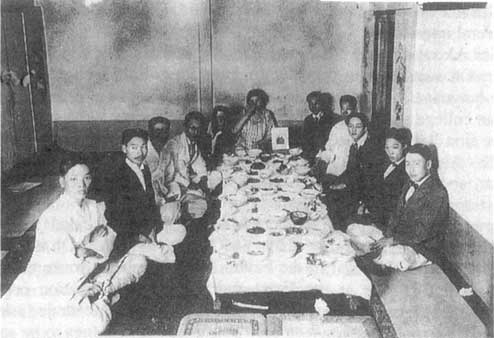 click for larger image The second of two meetings held in Seoul by Miss Alexander September 8 and 9, 1921. The first meeting was a Bahá'í Feast. Fifteen men total from the two nights wrote their names and brief notes to be forwarded to 'Abdu'l-Bahá. Miss Alexander is sitting at the far end. Mr. Oh Sang Sun is at the far end on the right. 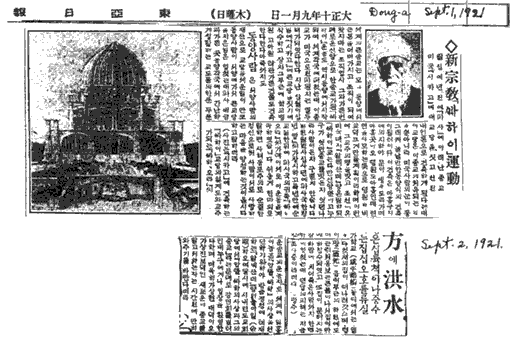 click for larger image Publicity about the Faith obtained by Miss Agnes Alexander during her first visit to Korea, 1921.
 click for larger image Miss Alexander's friend Mr. Oh Sang Sun taught at a Buddhist school in Seoul. Mr. Oh can be seen in the rear holding a frame. The others were students who attended Miss Alexander's talk October 18, 1923 during her second trip to Korea.[+CHAPTER2] 2. Tablet of 'Abdu'l-Bahá to the KoreansThrough Miss Agnes Alexander. To the new friends of Korea:- Sang Sun Oh, U. U. Cuan, Kinng S. Ko, Chy Rin, Inki Hong, Pyung C. Lee, Soon Y. Lee, Wen H. Ma, Young N. Pyeur, Chang Young Kim, Agnes Alexander, Z.Y. Roe, S. Wo Kloon, S. Y. Zee, Ze Kyung Sang, and S. T. Suh.
Praise be to God that celestial light guided and led you to the Sun of Reality, bestowed everlasting life and granted heavenly illumination. Ye are like seedlings which have been planted by the hand of Bestowal in His Spiritual Rose-Garden. It is my hope that through the warmth of the Sun of Reality, the pouring down of the showers of mercy and the wafting of the breezes of bestowal, ye may progress day by day, so that each one may become a blessed tree, full of leaves and flowers and throw your shade over great multitudes. The Graces of the Kingdom of Abhá are the rays of the Sun of Reality. It illumines the earth and heaven, makes the star a shining moon,
turns the speck into a huge mountain, bestows strength to the weak, gives everlasting healing to the sick, grants heavenly treasures to the poor, confirms the oppressed ones to everlasting glory and turns the people of darkness to those of light. 0 heavenly friends, the doors of heaven have been opened, the lights of God have shone forth and the heavenly Call has been raised. Summon ye all humanity to listen to this Heavenly Call and invite them to the Celestial world, so that they may find a new spirit and attain to a new life. In all conditions, my heart and spirit are with you. Upon ye be the Glory of Abhá.
Miss Alexander started corresponding with Korean Esperantists in the 1920s, one of whom was Mr. Kim Chang-zin. He became interested in the Bahá'í Faith and later he said that he became a believer about 1929. This would make him the first Korean to believe in Bahá'u'lláh. However, in those days there were no enrollment procedures. In The Bahá'í World Vol. II (1926-1928) there is a listing "The Bahá'ís of Seoul, 112 Kandong." This was apparently Mr. Kim and his group of Esperantists. In an Esperanto pamphlet printed in the United States in 1926, 112 Kandong, Seoul, is listed as an address for the "Bahá'í Assembly." Whether or not it was actually a Bahá'í group is not known. Miss Alexander did not refer to this in her written accounts. The Korean Bahá'í group was not listed again in The Bahá'í World volumes until the early 1950s when American servicemen enrolled new Bahá'ís. Except for Miss Alexander's correspondence with Mr. Kim and the Esperanto group in the 1920s, and possibly a little later, there seems to have been no Bahá'í contact with Korea until the early 1950s. [+CHAPTER3] 3. Letters from the Guardian in the Early 1950sAmong the first servicemen who went to Korea during what has been called the "Korean Conflict," from 1950 to 1953 when an armistice was signed, were Lt. Col. John McHenry, Lt. Jacob Davenport and Lt. Donald Witzel, who was there from April 1951 to June 1952. It was through Lt. Witzel's efforts that the first Korean formally enrolled in the Faith, in
1951. His name was Mr. Choi Woo Yong. He worked in Lt. Witzel's office as an interpreter as he could speak several languages. In those early years the pioneers sent letters and reports sometimes directly to the Guardian and also to Miss Agnes Alexander, who had been appointed Auxiliary Board Member in 1954 by the Hands of the Cause in Asia. Korea was a part of her jurisdiction. The pioneers also sent reports to the Asia Teaching Committee of the National Spiritual Assembly of the United States. Below, parts of letters are quoted which were written by, or on behalf of, the Guardian in answer to letters addressed to him concerning Korea. This correspondence documents the heroic efforts of the small band of devoted and dedicated American servicemen and pioneers. When Shoghi Effendi was informed of the enrollment of Mr. Choi a letter was written on his behalf to Lt. Witzel, as follows:
Your letter of September 5th took some time to reach our beloved Guardian, but brought him real joy. (The enclosures were also received). He was deeply moved to hear of the young man who has, through your example and kindness, embraced the Cause of God, and he feels this is an event of real spiritual importance for that miserable and war-torn land. Please convey to this new Bahá'í brother the loving greetings of the Guardian, and assure him that he is praying for him, and for his family, wherever they may be, in this world, and in the next. To be the first native believer is a great distinction and privilege. He hopes that Mr. Yong [Choi Woo Yong] will cling fast to the Faith he has found, at such a bitter moment in his life, and he will carry its light to other receptive, disillusioned and suffering souls. May Bahá'u'lláh bless you for your steadfastness and for your devoted services to His Cause. With warmest Bahá'í love, R. Rabbani
Assuring you of my loving and fervent prayers for your protection and for the success of every effort you exert for the promotion of our beloved Faith. Your true brother, Shoghi
It is with great joy that our beloved Guardian received your letter of
May 28, which he has instructed me to answer on his behalf. It is strange and wonderful to think that out of the bitter misery of the Korean war, the Faith of Bahá'u'lláh should have been brought to that distant land by Bahá'í soldiers. It shows us that the Plan of God for this day goes forward in spite of the blindness and hatred afflicting the human race today. The Guardian is planning as part of our world-wide Bahá'í Crusade, to start during the next year, to have some of our writings translated into Korean. This will enable the Korean Bahá'ís like yourself and our dear brother Mr. Choi, to teach this glorious Faith to your fellow countrymen with greater ease. You must never lose heart; the ordeal of humanity is not yet over for alas, men have not yet learned the Plan of God for them, and still cling to their selfishness, their blind nationalism, and prejudices. But they will through suffering and disillusionment, learn that the Plan of Bahá'u'lláh is their only hope, and gradually they will turn to it more and more. In the meantime you have the privilege and blessing of having seen and recognized the Truth, and you will be able to share it with many other hungry young people. You may be sure that the Guardian will remember you and surround you with his loving prayers. With warmest Bahá'í greetings, R. Rabbani
Assuring you of a most hearty welcome into the Bahá'í fold, of my loving and fervent prayers for your spiritual advancement, and for the success of every effort you exert for the progress of our beloved Faith in your native land. Your true brother, Shoghi
The news your letter of May 28 conveyed brought great joy to the heart of the beloved Guardian and he has instructed me to answer you on his behalf, and I am also enclosing his reply to Mr. Hyun [Kyung Koo Hyun] which you will please deliver to him. Through the purity of your heart and your great dedication to the Faith God has enabled you to confirm two souls in the Cause there. This has brought great happiness to Shoghi Effendi, as it marks the beginning of our Bahá'í work in Korea -- the beginning of its successful spread. When the plans for the next ten years' intercine teaching work are formulated, Korea will be one of the objectives, and these two young Bahá'ís will find assistants in the form of pioneers and literature reaching
them. Meantime, you should do all you can to strengthen the roots of their faith, so that, if and when you are forced to leave them, they will be strong enough to go on alone, at least temporarily. [Signed by R. Rabbani, August 5, 1952]
He [the Guardian] was deeply touched by the two letters by the new believers of Korea, and the spirit of loving devotion which they portray. He wishes you to send them his loving greetings, and to assure them of his prayers in their behalf. He hopes they will be inspired to intensify their teaching efforts, so others may be quickened by the spirit of Bahá'u'lláh, and an Assembly be formed in Korea. He wishes you and the friends in Tokyo to keep in close touch with the friends in Korea. In fact, he wishes the Tokyo Assembly to undertake, as one of their direct responsibilities, the assistance of the work in Korea. This will keep the Center in Korea (and even enable it to develop into an Assembly) until such time as more American pioneers are sent to Korea. Under all circumstances, the foothold the Faith has in Korea, should be maintained, and developed. The Guardian has also written to the American NSA about the importance of this matter. [Signed by Leroy Ioas, May 25, 1953] Several other Americans who contributed greatly to the development of the Faith in Korea went there immediately after the Korean War. William Maxwell was stationed in Korea with the U.S. Army in May 1954. He was released from the Army the next year, 1955, and stayed in Korea teaching at a university in Kwangju, becoming the first resident pioneer in Korea, not counting those attached to the U.S. military. He was appointed Auxiliary Board Member in 1957. In 1959 he married an American pioneer to the Caroline Islands, Miss Mary Hill, and the two stayed in Korea until 1963 when they returned to the United States. Mr. Maxwell pioneered to several other countries, and was appointed to the Continental Board of Counsellors for Northwest Africa in 1967. He and wife pioneered again in Korea from December 1990 to March 1993.
Letters written on behalf of the Guardian to Mr. William Maxwell: He [the Guardian] was immensely pleased over the gathering of the American and Korean friends together; and he feels that this marks a new milestone in the progress of the Cause in that country... Please convey his warmest love and assurance of his prayers, to the Korean friends and to the other Bahá'ís there. There is a great future for the Faith in that area, not only spiritually, through the spread of the Bahá'í Teachings, but in the material world too, as 'Abdu'l-Bahá has foretold. Therefore, he urges the believers there to encourage the people, and bring them into the Faith, at the same time using discretion, so as not to cause any opposition at this stage. [Signed by R. Rabbani, December 4, 1954]
The beloved Guardian assures each and every one of the friends in Korea of his appreciation of their devoted services. He is praying for them; for their spiritual development; and for great success in their teaching work. He sends each of you his loving greetings. [Signed by Leroy Ioas, July 2, 1955]
[Signed by Leroy Ioas, October 19, 1955]
The Guardian was happy to learn that you are still in Korea and that you are able to continue in the teaching work of that important country. He knows that wherever you are you will carry forward the pressing requirements of the Faith with vigor and enthusiasm but he feels that Korea and even Japan particularly need the help of yourself and other American pioneers at this time. [Signed by Leroy Ioas, August 18, 1957]
A letter written on behalf of the Guardian to Mr. William Smits and Mr. William Maxwell follows: He [the Guardian] was overjoyed to receive the wonderful news you conveyed of the progress being made in Korea, of the activity of the dear Korean believers, and the fact that new souls are being interested. He was particularly glad to receive the pamphlets printed in Korean, an achievement of which he is truly proud. Please express on his behalf to the Korean friends who assisted in this work his deep appreciation of this historic service they have rendered the Faith, and tell them that he is praying for them in the holy Shrines, and that, through them and with your help, their fellow-countrymen may come to hear of the Faith, and receptive souls be found who will arise to serve it. [Signed by R. Rabbani, March 12, 1955]
A letter written on behalf of the Guardian to Mr. John McHenry III follows: He [the Guardian] is very happy you can arrange your affairs so as to return to Korea, and you may be sure that he will ardently pray in the holy Shrines that the way may open for you to find work and be able to settle there.
The phenomenal progress the Cause has made in that area is practically exclusively due to the services of young American Bahá'ís who are in the Armed Forces. Indeed, it is a great victory won by Bahá'í youth. [Signed by R. Rabbani, March 18, 1957]
4. The Immediate Post-Korean War PeriodIn 1954 Miss Alexander took up again her correspondence (in Esperanto) with Mr. Kim Chang-zin. He had somehow heard that she was living in Kyoto, Japan and managed to contact her. She and Mr. Kim had corresponded in the 1920s and shared a keen interest in Esperanto. During the later years their correspondence was cut off due to the political situation.On January 10, 1954 Mr. Kim wrote to her, "It is with great joy that I write a letter to you after twenty and some years." He also wrote that during the war, "Regrettably, I lost two of my most precious possessions, a portrait of 'Abdu'l-Bahá and a book about Bahá'í." After being asked, MSgt. Kirby Kent, one of the American Bahá'í servicemen, went looking for Mr. Kim in Chunan, where he lived. In May 1954 Sgt. Kent wrote to Miss Alexander of finding Mr. Kim and of the happy time they had together. He wrote that Mr. Kim was eager to get Bahá'í literature in Japanese, which he could read. In December of that year Mr. Kim was able to go to Seoul to attend a "Christmas" meeting of the Seoul friends. At that time he happily signed his enrollment card, as he felt he had been a Bahá'í since the late 1920s. He is now considered to have been the first Korean believer. Mr. Kim was a staunch believer through the years. He attended the first convention of the Bahá'ís of North East Asia in 1957, although he was not a delegate. He was the first Korean Bahá'í to go home-front pioneering when he went to the then unopened island of Cheju in late 1957. He was one of two Korean Bahá'ís to attend the first World Congress in London, 1963 at the invitation of the National Spiritual Assembly of North East Asia. He was elected to the first National Spiritual Assembly of Korea in 1964 and he translated Bahá'u'lláh and the New Era, which was published in 1965. Mr. Kim died in 1990 and was buried according to Bahá'í law in the New World Cemetery near Seoul.
 Sgt. Kirby Kent finds Mr. Kim Chang-zin, April 1954. Sgt. Kent had Mr. Kim's address in Chunan and went looking for him. Sgt. Kent later wrote to Miss Alexander of visiting her old Esperanto friend. He said it was not difficult to find him but that they had to speak through an interpreter. Once Mr. Kim was found he quickly identified himself as a Bahá'í and was staunch and faithful until the end. He is considered to be the first Korean believer in Bahá'u'lláh.Mr. Oh Sang Sun, who had known Miss Alexander since the very early days in Japan and who had helped her so much when she made her first trip to Korea in 1921, was located by Mr. Maxwell in Seoul in 1954. Over the years Mr. Oh had become an eminent poet. He recalled Miss Alexander and the Bahá'í Faith with great affection. In spite of his close association with the Bahá'ís he could not go that last step and sign an enrollment card which would indicate a full commitment to the Faith. When Miss Alexander made her first trip to Korea in over 30 years in 1955, she had a very emotional reunion with both of her old friends, Mr. Oh and Mr. Kim. Interestingly, she had never actually met Mr. Kim but only corresponded with him. By July 1954 there were several American servicemen Bahá'ís and four Korean Bahá'ís: Mr. Suh Eton, who had become a Bahá'í in the United States while he was attending the University of Michigan, Mr. Choi Woo Yong, Mr. Kim Chang-zin and Mr. Kyung Koo Hyun. Mr. Kim Chang-zin had not yet signed an enrollment card because he was not living in Seoul and distances were great in those days. However, he was considered a Bahá'í by the friends in Korea. Mr. Kyung Koo Hyun, also called "Joseph", the only Korean to receive a direct letter written on behalf of the
Guardian, was not on any membership list nor was any reference made concerning him from then on. In September of that year Mr. Maxwell wrote to the Asia Teaching Committee of the National Spiritual Assembly of the United States that Korean Army Capt. Kim Won Be, and his wife, Hwang Chun Jee, had become Bahá'ís. She was the first Korean woman to declare her belief in Bahá'u'lláh. They were the fifth and sixth Koreans to become Bahá'ís. They were active for several years and then moved out of Seoul and ceased activity. In October Mr. Maxwell moved closer to Seoul from Wonju where he had been based. This contributed to the activity in Seoul. [+CHAPTER5] 5. The First Public Meeting in the Post-War YearsThe first public meeting in Korea, since that one years before in 1921 at which Miss Alexander spoke, was held at the Seoul YMCA, on November 12, 1954 and commemorated the Birth of Bahá'u'lláh. It was an all-day meeting with three sessions: in the morning, afternoon and evening. The Bahá'ís who conducted the day's meetings were Mr. Maxwell; Mr. Smits; Mr. Suh Eton, who was an instructor at a language institute; Arthur Gaynes, an American serviceman friend of Mr. Maxwell who had become a Bahá'í in Korea that year; Mr. Choi Woo Yong; Mr. Oh Sang Sun, who was not a registered Bahá'í but friendly to the Faith; Richard Wright and Richard Allen, American servicemen who were Bahá'ís; and Capt. and Mrs. Kim Won Be, new Bahá'ís who were friends of Mr. Maxwell. In the evening session there were nine Bahá'ís, five Americans and four Koreans, and eight non-Bahá'ís to listen to Mr. Suh Eton speak.This first meeting was considered to have been a success and at least one person declared his belief in Bahá'u'lláh. The Bahá'ís sent a cable to the Guardian informing him of their historic meeting, and listing the names of the Bahá'ís so far in Seoul. The Guardian answered via the National Spiritual Assembly of the Bahá'ís of the United States, "Rejoice news assure loving prayers, Shoghi." The next month the Bahá'ís of Seoul decided to have a "Christmas" meeting which was held in a private room of a Chinese restaurant. The program was entirely in Korean with Capt. Kim Won Be and Mr. Kim Chang-zin speaking. It was attended by three adult Korean believers, three students and three U.S. servicemen Bahá'ís. The lack of Bahá'í literature in Korean was a major problem in those early days. At that time most Koreans could read Japanese so they were provided with Bahá'í pamphlets from Japan. But even so, there was only a small selection. One of the priorities of the small community was to print a pamphlet in Korean. This goal was accomplished in January 1955
with the printing of 1000 copies of an introductory pamphlet. It was translated from Japanese the year before by Capt. Kim Won Be and reviewed by Mr. Choi Woo Yong and Mr. Oh Sang Sun, who was a friend of the Faith. A copy of the new pamphlet was sent to the Guardian and a letter written on his behalf reported that the Guardian was "truly proud" of
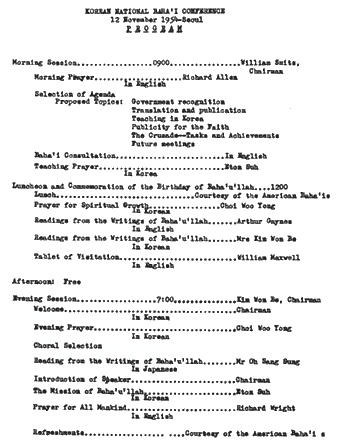 click for larger image The program of the first post-war public meeting in Korea, November 12, 1954 on the occasion of the Commemoration of the Birth of Bahá'u'lláh. It was an all-day meeting with three sessions; the first endeavor in which most of the Bahá'ís in Korea participated. their achievement. Mr. Maxwell and Mr. Smits sent 100 copies of the pamphlet to then Auxiliary Board Member Miss Alexander who was in Japan. They wrote to her, "The pamphlets were unveiled at the regular fireside where twenty-one people were present, including three officials from the firm which had printed them, one of whom declared his intention of becoming a Bahá'í." The pamphlet was printed again in 1960, revised and with a new cover, 2000 copies. The community had also mimeographed twenty copies of prayers in Korean with the intention of eventually printing them professionally. The community had regular Bahá'í activities and by February 1955 there were six adult Korean Bahá'ís and two youth. On April 1, 1955 the small group in Seoul was so happy when the ninth Korean declared her Faith -- Miss Hong Hie Sook, the third woman to do so -- that they sent a cable to Shoghi Effendi informing him of this good news. He answered "Delighted. Praying success Seoul friends, Shoghi."
 The first Bahá'í pamphlet to be printed, 1000 copies, in Korean, 1955 (left). It was translated from Japanese by Capt. Kim Wong Be and worked on by a committee in Seoul. A copy was sent to Shoghi Effendi and a letter written on his behalf reported that he was "truly proud" of their achievement.[+CHAPTER6] 6. 1955In November 1955, just one year after the first public meeting in the post-war period, Mr. Maxwell wrote an assessment of the situation in Korea. During the year his Army tour of duty had ended. He was hired by Chunnan University in Kwangju, to teach English to some 1500 students at various campuses. He held regular study classes for students and teachers. A one-day teaching trip was made to an island which contained lepers and slides of the World Center were shown.Literature had been placed in various libraries, the first introductory pamphlet in Korean had been printed and there had been much proclamation with many people hearing of the Faith. That year the Bahá'ís in Seoul were having regular firesides with an average attendance of about 12 people. Mr. Smits was pioneering in that city. Despite enrollments in both Kwangju and Seoul the Bahá'ís were not able to form Local Spiritual Assemblies in either city that year. In Seoul they sometimes had difficulty finding a place to hold meetings and ended up by having them at a Salvation Army facility. In 1955 Miss Alexander made a historic three-week trip to Korea in her capacity as Auxiliary Board Member, a position to which she had been appointed May 1, 1954 by the Hands of the Cause in Asia. A high point of her trip was meeting her two old friends, Mr. Oh Sang Sun and Mr. Kim Chang-zin. Mr. Smits and Mr. Maxwell arranged several meetings for Miss Alexander. Each day there was an activity and when she didn't go out, her hotel room was continually filled with Bahá'ís and their friends. She wrote that she had no trouble communicating with the Koreans. If they couldn't speak English, she communicated with them in Japanese. She wrote that she particularly enjoyed meeting two outstanding Bahá'ís, Mr. Choi and Mr. Kim Young Kyung. In 1955 the first youth declared as a result of dedicated teaching in Seoul, Lee Sung Yul, and after him Oh Jung Song, both fifteen years old. They listed their address as Eden's Orphanage in Seoul. Actually the first youth to declare in Korea was Kyung Koo Hyun in 1952 but he was not to be found in later years.
The First Asian Teaching Conference, Nikko, JapanDuring the fall of 1955 the first Asian Teaching Conference was held in Nikko, Japan, sponsored by the National Spiritual Assembly of the United States and hosted by the Tokyo Local Spiritual Assembly. Hand of the Cause Mr. Zikrullah Khádem attended as the representative of the Guardian. There were participants at the conference from several countries. Two Korean Bahá'ís had planned to attend but could not obtain passports to
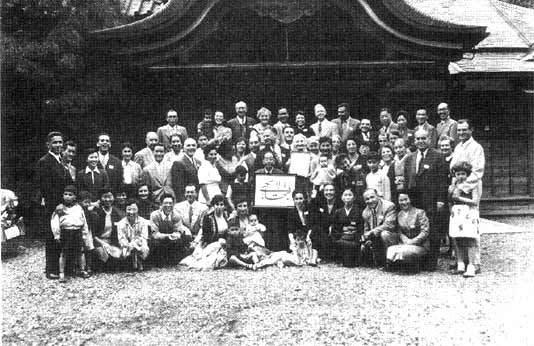 click for larger image The First International Teaching Conference in Asia The first Winter School was held in Kwangju for one week at the end of December, 1955. The number of people registered was 36, which included thirteen new Bahá'ís. The average attendance for all sessions was 24. A variety of subjects was discussed: The Guardianship, The Divine Plan of 'Abdu'l-Bahá, The Ten Year Crusade, Bahá'í Laws, Korean Bahá'í history. Mr. Roe (Roh Chung-il) was present and he described his visit with 'Abdu'l-Bahá. Two public meetings were held at Mr. Maxwell's home, which was the unofficial Center for Kwangju. One meeting was for professors and the other for students. Dr. David Earl, who was based in Japan, attended, and according to the participants did "inspired teaching." He also brought a table tennis set which was enjoyed during free time. [+CHAPTER7] 7. The First Local Spiritual Assemblies in Korea, 1956By January 1956 there were 14 new Bahá'ís in Kwangju, all mature students, and extension teaching had begun in Mokpo.In a landmark victory for the Faith the first two Local Spiritual Assemblies were elected in Korea, in Seoul and Kwangju, at Ridván 1956. They were a part of the twelve which were elected in the North East Asia area: the others were eight in Japan, one in Hong Kong, and one in Taiwan. They would form the local pillars to support the eventual National Spiritual Assembly of the Bahá'ís of North East Asia, with its seat in Tokyo, Japan. Miss Lecile Webster, an American pioneer who worked for the U.S. Embassy in Tokyo, Japan, was transferred to Seoul that January. At that time Hand of the Cause Miss Alexander wrote to the Hands of the Cause in Asia, that "[Miss Webster's move] is surely God's Plan as it came in answer to the prayer she and Mr. Khádem said for her guidance." Mr. Smits also returned to Seoul that January after an absence of several months, during which he went to the United States and also made a pilgrimage to the Holy Land. Miss Webster wrote to Miss Alexander of that first historic election in Seoul. Mr. Smits lit candles that he had brought from the Shrine of the Báb, following his recent pilgrimage, and he had some attar of roses given him by the Guardian for the Korean Bahá'ís. According to the report
there were nine Bahá'í men and three Bahá'í women in Seoul at that time, with eleven Bahá'ís attending the election, which was held at the residence of Mr. Suh Eton. Those elected to the Local Spiritual Assembly were Mr. William Smits (chairman), Mr. Suh Eton (vice-chairman), Dr. Lee Yong-so (treasurer), Mr. Choi Woo Yong (secretary), Mr. Yang Hee-ghon, Dr. Oh Hyon-suk, Miss Chee Hei Soon, Mr. Youn (Yun) Sok-bong, and Miss Lecile Webster. The three other adult members of the Seoul community were Mr. Chang Moon Chan, Mr. Huh Hon and Mr. Kim Chang-zin, who by this time was living in Seoul but was unable to attend the election. Miss Chee was the second Korean woman to accept the Faith. Miss Webster left Korea the next year before Ridván. The Local Spiritual Assembly of Seoul informed the Asia Teaching Committee of the National Spiritual Assembly of the United States that the first Bahá'í youth of Seoul, Lee Sung Yul, would be visiting the United States. Many of the early Korean Bahá'ís went to the United States to visit or study -- some stayed active but many did not. Kwangju had twenty resident Bahá'ís at the time of their first election. According to Mr. Maxwell's report to Miss Alexander nineteen of the twenty Bahá'ís attended the election, one being out of the city. The nine Bahá'ís elected to that assembly were Mr. William Maxwell (chairman), Mr. Kim Je Hyub (treasurer), Mr. Kim Yeon Kyun (secretary), Mr. Pak Chong Huen, Mr. Oh Je Dong, Mr. Yoon Kang Joon, Mr. Im Pyoung Mo, Mr. Cho Se Hyun and Mr. Chung Hwan Kuc. Some years later Mr. Maxwell wrote that six of those members, some of whom were medical students at that time, had become highly successful physicians. The new Kwangju Local Spiritual Assembly was quite active. They appointed eight committees and all seem to have been working. One was the Wolbo newsletter committee, with the first issue being printed in June 1956. The Assembly reported that in October they were printing 100 copies. As there was also a mimeographed Wolbo in Seoul, the Bahá'ís were able to communicate in a way that made for Bahá'í unity throughout the community in Korea. The Assembly decided to host a Summer Conference in July. Iranian pioneers Mr. Abbas Katirai and Mr. Ataullah Moghbel attended from Japan. (Mr. Maxwell commented that they were probably the first Persians to go to Korea in modern history and when they left, all the LSA members and several other friends went five miles to the train station to see them off.) Mr. Smits, Miss Webster and two women, Dr. Oh and Miss Pang, went to the conference from Seoul. The day-time attendance varied between twenty-five and forty, with Bahá'ís constituting about half of the audience. There was one press conference with two of the largest newspapers in the area, the Chonnan Ilbo and the Honan Press. A mimeographed sheet giving basic information about the Faith had been prepared to hand out. One of the newspapers printed the equivalent of one
page in two different issues about the conference and included a photo of 'Abdu'l-Bahá.
 click for larger image The first Local Spiritual Assembly of the Bahá'ís of Kwangju, elected 1956. Front: Mr. Yoon Kang Joon, Mr. William Maxwell (chairman), Mr. Kim Yeon Kyun (secretary) and Mr. Pak Chong Huen. Standing: Mr. Chung Hwan Kuc, Mr. Cho Se Hyun, Mr. Oh Je Dong, Mr. Kim Je Hyub (treasurer) and Mr. Im Pyoung Mo. 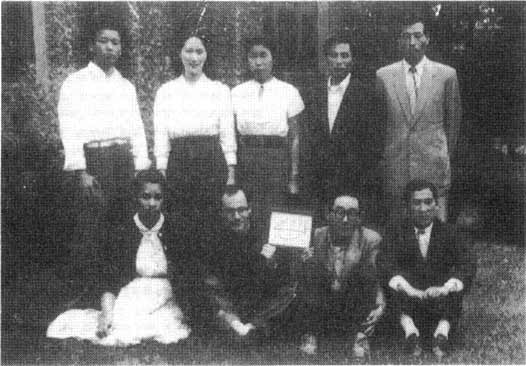 The first Local Spiritual Assembly of the Bahá'ís of Seoul, 1956. Front left to right: Miss Lecile Webster, Mr. William Smits (chairman), Mr. Suh Eton (vice-chairman) and Dr. Lee Yong-so (treasurer). Standing: Mr. Yang Hee-ghon, Dr. Oh Hyon-suk, Miss Chee Hei Soon, Mr. Choi Woo Yong (secretary) and Mr. Yun Sok-bong. Miss Chee was the second Korean woman to accept the Faith. 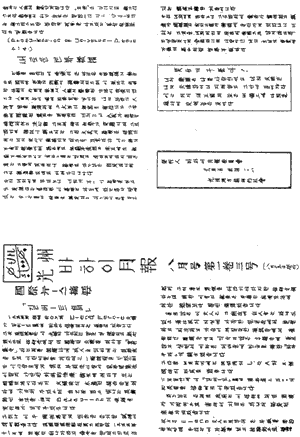 click for larger image
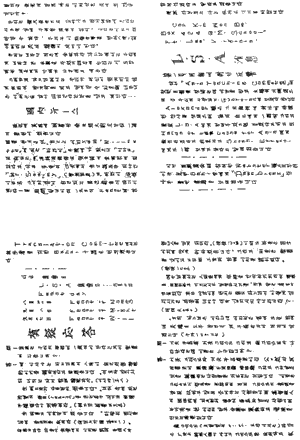 click for larger image The Wolbo, a monthly newsletter put out by the Kwangju Local Spiritual Assembly. The first issue was June 1956. The one shown above was Vol. 1, No. 3, August 1956. The Assembly indicated that they wanted to send it to other communities in Korea. By mid-June Bahá'ís resided in four localities.
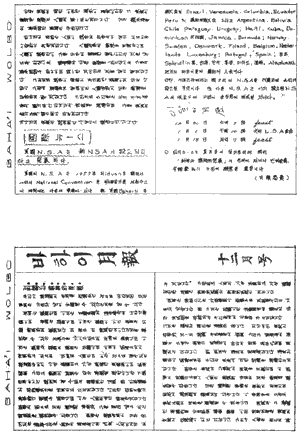 click for larger image
 click for larger image The Wolbo put out by the Local Spiritual Assembly of the Bahá 'is of Seoul. This one is dated December 1956. The Bahá'ís of Korea were also receiving the Japanese Bahá'í Geppo (monthly news). They were hungry for news. A public meeting in connection with the conference had a surprisingly high attendance, mostly students, doctors, professors, and graduate students. It was estimated that at one time or another at least 100 people came to the conference, the majority being university students. The Bahá'ís considered the conference a great success and they felt that they had become infused with a new spirit. By April 1956 there were 30 Korean Bahá'ís and three American Bahá'ís. The Faith started expanding. By mid-1956 there were two Bahá'ís in Mokpo, one adult and one youth, and one Bahá'í in Hwason who had moved from Kwangju where he had originally become a Bahá'í. There were now four localities which had resident Bahá'ís. It seems that the success of the Summer Conference encouraged the Kwangju community to also hold a one-week Winter Conference during the last week in December of that year. It was also a resounding success. This one had 100 people in attendance at one time or another, including the new Bahá'ís in Mokpo. Mr. Philip Marangella was able to attend from Japan where he was pioneering. According to a report, the conference provided a "boost in spiritual joy and an awareness of Bahá'í love." [+CHAPTER8] 8. Korea Becomes a Part of the North East Asia Community, 1957In April 1957 the Local Spiritual Assemblies of Seoul and Kwangju were again elected. However, this time the Kwangju Assembly consisted entirely of Korean Bahá'ís. At that time the number of adult Bahá'ís was Kwangju 26; Seoul 11; Mokpo 2 (Mr. Moon Sam Suk and Mr. Yang Hyo Jong): Pusan 2 (Capt. and Mrs. Kim Won Be); isolated 1 (Mr. Chung Chai Churl) and 20 youth. A report sent two months later lists 14 adult Bahá'ís and four youth in Seoul. There were three American pioneers in Korea, Mr. Smits (in Seoul), Mr. Maxwell (in Kwangju but soon to leave that city) and Miss Webster (in Seoul), who was soon to leave Korea.In April 1957 the first Convention of the Bahá'ís of North East Asia took place in Tokyo, Japan, which had been designated by the Guardian to be the seat of the new National Spiritual Assembly. The communities represented were Japan, Korea, Taiwan, Hong Kong and Macau. Originally the Russian island of Sakhalin, north of Japan, and Hainan, an island off the coast of southern China, had been included, but because at that time there was no entry to either island they were dropped from the area. Sakhalin remained a goal for the National Spiritual Assembly to open, however. This was accomplished many years later, in 1990 from Japan. Korea was represented at the convention by four delegates: Mr. Oh Je Dong, Mr. Kim Dong Sun, Mr. William Maxwell and Mr. William
Smits. Mr. Kim Chang-zin and Mr. Hahn Byoung Teck also attended as visitors.
 click for larger image This is a reduced copy of Shoghi Effendi's letter to the first Convention of the Bahá'ís of North East Asia. It was hand-carried to Tokyo by the Guardian's representative to the Convention, Hand of the Cause Mr. Jalal Khazeh. The convention was attended by two Hands of the Cause: newly appointed Miss Alexander, and Mr. Jalal Khazeh, who was the Guardian's representative at the convention. He brought two or three vials of attar of roses given by the Guardian to anoint the friends. (One of the vials he gave to the present writer. One whiff and memories of that time so long ago are quickly evoked.) After the convention Mr. Khazeh visited Korea, the first Hand of the Cause to do so. (Miss Alexander had visited Korea previously in her capacity as Auxiliary Board Member.) Mr. Khazeh met with the Local Spiritual Assembly of Seoul twice and expressed the opinion that the assembly was quite strong. He also met with the Local Spiritual
 Four Korean Bahá'ís shown with Hand of the Cause Mr. Jalal Khazeh attended the first National Convention of the Bahá'ís of North East Asia, in Tokyo, Japan, 1957. From the left: Mr. Kim Chang-zin, Mr. Hahn Byoung Taek, Mr. Khazeh, Mr. Kim Dong Sun and Mr. Oh Je Dong. Mr. Oh and Mr. Kim Dong Sun were delegates; the other two were visitors. Assembly of the Bahá'ís of Kwangju and gave them explanations as to how to function. He spoke at Chunnan University with about 150 students present. His talk was translated by Mr. Oh Je Dong. In his report he wrote that he had had a press conference with six reporters present. He expressed appreciation to "dear Maxwell and dear Smits" who made his arrangements. The Ten Year Plan encompassed the years 1953 to 1963. When the National Spiritual Assembly of North East Asia was elected there were six years left so the Assembly was issued a subsidiary plan which was designed just for the newly-elected assembly, called the Six Year Plan. At that time there was no specific plan for Korea, but a general one for all of North East Asia. The Guardian wrote to the new National Spiritual Assembly (in part): "The Six Year Plan, designed to lend a tremendous impetus to the awakening of the peoples and races in those regions, should be prosecuted with the utmost diligence, unrelaxing vigilance and wholehearted consecration. All must participate, young and old alike, both men and women, however limited their circumstances or circumscribed their resources. "An effort, unprecedented in its scope and intensity, must be exerted to attain, speedily and completely the specific objectives of this Plan. The number of the avowed supporters of the Faith must rapidly increase. The isolated centers, groups and local assemblies, constituting the bedrock of a rising Administrative Order, must steadily and continually multiply. All firmly grounded local spiritual assemblies must be speedily incorporated, in order to reinforce the foundations of the institution of this divinely conceived Order. The Bahá'í Marriage certificate, as well as the Bahá'í Holy Days must, at the earliest possible opportunity, receive recognition from the civil authorities concerned. The work now being initiated in the Northern, and smaller islands of Japan, with such zeal and devotion should be constantly reinforced and its scope continually widened. The literature of the Faith must be translated into as many languages as possible, published and widely disseminated. The holding of summer-schools is yet another objective that should receive the earnest and immediate attention of the members of your assembly. The purchase of the Bahá'í burial-grounds, should, moreover, be, in due course considered and effectively carried out. The newly opened territories, that have been so painstakingly brought within the pale of the Faith, must at whatever cost, be safeguarded, and the enterprises initiated within their confines carefully expanded and consolidated. The acquisition of a plot, in the outskirts of Tokyo, to serve as the site of the first Mashriqu'l-Adhkar of North East Asia, must, likewise, be seriously considered and brought to a successful conclusion." These goals were applied to all Bahá'í communities in North East Asia.
 click for larger image Mr. Jalal Khazeh was the first Hand of the Cause to visit Korea. This photo was taken with the Kwangju Bahá'ís in May, 1957. Miss Agnes Alexander had visited Korea earlier but at that time she had not yet been appointed Hand of the Cause.  click for larger image The first National Spiritual Assembly of the Bahá'ís of North East Asia, elected April, 1957 in Tokyo, Japan. The area of the Assembly included Japan, Korea, Taiwan, Hong Kong and Macau, with its seat in Tokyo, Japan. Seated: Mr. Noureddin Mumtazi (treasurer), Miss Agnes Alexander, Mrs. Barbara R. Sims (recording secretary), Mr. Hiroyasu Takano (vice-chairman). Standing: Mr. Ataullah Moghbel, Mr. Michitoshi Zenimoto, Mr. Philip Marangella, Mr. Yadollah Rafaat (secretary), Mr. William Maxwell (chairman). According to a letter written on behalf of the Guardian he was "happy to see that (the) Assembly has represented on it members of the three great races of mankind, a living demonstration of the fundamental teaching of our Holy Faith."[+CHAPTER9] 9. More About the Late 1950sAlthough Korea had had Winter Schools and Summer Conferences, the first officially designated Summer School, under the Six Year Plan, was held in Kwangju in 1957. To establish Summer Schools was a goal of the Six Year Plan given by the Guardian to the new National Spiritual Assembly. The Kwangju Summer School was attended by Miss Alexander who visited Korea for the first time in her capacity as Hand of the Cause. The participants at the Summer School sent a message to Shoghi Effendi that 100 Bahá'ís and friends representing four Korean centers were pledging their efforts to achieve the goals of the Six Year Plan.The Guardian responded with a cable: "Delighted assure attendants fervent prayers extension activities consolidation newly born institution. Deepest love, Shoghi." Mr. Noureddin Mumtazi, a pioneer in Japan who attended the Summer School, expressed surprise at how quickly the young Korean Bahá'ís had gained knowledge of literature and teachings of the Faith.
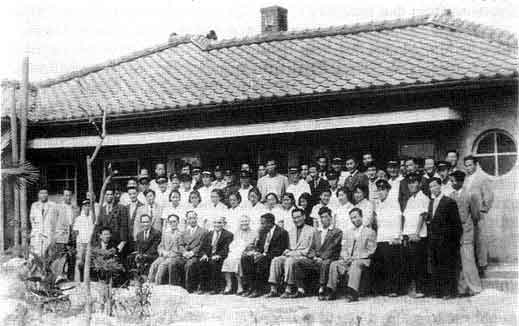 click for larger image The first Bahá'í Summer School in Korea, held in Kwangju, September 28, 29, 30, 1957. Hand of the Cause Miss Alexander is sitting in the front row. To the right of her is Mr. Maxwell; to the left is Mr. Noureddin Mumtazi from Japan and next to him is Mr. Kim Chang-zin. Mr. Smits is second to the left of Mr. Kim. Over 100 Bahá'ís and their friends attended this highly successful summer school. To establish the institution of Summer Schools was one of the goals of the Six Year Plan given to the new National Spiritual Assembly of the Bahá'ís of North East Asia. In July 1957 Mr. John McHenry III pioneered to Korea at the Guardian's suggestion. He settled in Kwangju and obtained a teaching position at Chosun University. By this time Mr. Maxwell had left Kwangju to take a position with the U.S. Army Education Center near Seoul. Mr. William Maxwell was appointed Auxiliary Board Member in December 1957 by the Hands of the Cause in Asia. He was the first to be so appointed for Korea. As he was also the chairman of the National Spiritual Assembly of the Bahá'ís of North East Asia and had to go to Tokyo for the monthly meetings, he had much responsibility. Some years later, in 1962, Hand of the Cause Miss Alexander announced that Mr. Maxwell was appointed Auxiliary Board Member for Protection of the Faith. In those early days both Hands of the Cause and Auxiliary Board Members served on elected administrative institutions such as National and Local Spiritual Assemblies. This changed in Ridván 1963, when the Hands of the Cause decided not to serve on administrative institutions so as to leave themselves free to travel and teach the Faith. Auxiliary Board Members, with a few exceptions, also did not serve on administrative institutions from that time on. That year, 1957, more literature was added. "Ten Lesson Course," written by Mrs. Mamie Seto, was translated and 700 copies were printed in November. It was revised and reprinted the next year. The material for the Ten Lesson Course, which was most useful for deepening the new Bahá'ís, was taken from Bahá'u'lláh and the New Era, which had not yet been printed in Korean. In November the sorrowful news of the passing of Shoghi Effendi, Guardian of the Faith, shocked the entire Bahá'í world. One of the pioneers wrote of the memorial meeting in Kwangju. During the devotional services there was sudden wind and rain, cutting off the electricity. They continued their service by candlelight. Still the teaching went on. The next day extension teaching was done in Mokpo, with 21 people present. In December 1957 Mr. Kim Chang-zin went home-front pioneering to the unopened island of Cheju. Unfortunately he could not obtain work and was obliged to return to Seoul several months later. In early 1958 Mr. Smits sent a report to the National Spiritual Assembly of North East Asia informing them of the passing of Mr. Moon Sam Suk, who had become a Bahá'í in Mokpo in 1956. "[His] devoted efforts in teaching the Faith and helping to organize the fireside in Mokpo will ever remain a matter of history. He is the first Korean believer to ascend to the spiritual world." In another report, the new pioneer to Korea Mr. John McHenry III commented, "The radiant soul of Moon Sam Suk, which was reflected so strongly in his gentle and cheerful face, will surely aid us in the erection of the assembly he worked so faithfully to see
created and which was the object of his highest hopes." Mr. Moon had exerted his utmost efforts and a report stated one result was a "small column in a Mokpo newspaper which mentioned the glorious word Bahá'í." At the time of his passing four persons were ready to declare their belief in Bahá'u'lláh and by April the first Local Spiritual Assembly was elected in Mokpo. The members were Mr. Yang Hyo Chong (chairman), Mr. Ahn Chull Soon (treasurer), Mr. Rhee Yeun Sup (secretary), Mr. Kim Dong Oun, Mr. 0 Sun Taek, Mr. Heo Man Sik, Mr. Rhee Bong Doll, Mr. Rhee Bong Keun and Mr. Rhee Chae Im. There were now thirteen Bahá'ís in that city; twelve men and one woman, all Koreans. By mid-1958 there were more than fifty Bahá'ís scattered over seven localities which included three Local Spiritual Assemblies -- Seoul, Kwangju and Mokpo -- two groups and two isolated centers. The early Bahá'ís in Korea, even with few teachers available, were continually looking for ways to expand the Faith to other areas. Bahá'ís in the Seoul community made several teaching trips that year: to Taegu where they were interviewed by three newspapers; to Inchon for the first time where they looked for a permanent meeting place where they could have regular firesides; to Cheju Island where Mr. Kim was living; and to Koha Island. Mr. Yang Hyo Jong of Mokpo moved to Uijongbu thereby opening up another area. That year, 1958, the Bahá'ís of Kwangju participated in the United Nations Day and Human Rights Day program sponsored by the United Nations Association. Mr. John McHenry III was the Bahá'í speaker. His talk, which was translated, was heard by about 1500 students. Other speakers included a congressman, a president of one of the universities in that city, the president of the Women's Association, director of the United States Information Service, and others. Mr. McHenry wrote that the number of students coming to the firesides increased after that occasion. He also sent a report referring to the Wolbo newsletter issued from Kwangju during 1956-1958, modeled after the Japanese Geppo. The Seoul community was having two weekly firesides, one for students and one for adults. In an effort to hasten the deepening of new believers, the Seoul Assembly invited any Korean Bahá'í to come and spend the weekend at their Center, which was Mr. Maxwell's residence. A study conference was held in Seoul in November, 1958 at which Mrs. Mamie Seto, Auxiliary Board Member from Hong Kong, was the featured speaker. The conference culminated in a public meeting at which Mrs. Seto spoke. It was attended by 50 people. Kwangju held a similar study conference with Roy MacDonald, a U.S. serviceman from Seoul, as featured speaker. During that year, 1958, the community benefited by the printing of 2,000 copies of Paris Talks, the first Bahá'í book in Korean. It was translated by Mr. Suh Eton. Two new pamphlets were also printed in
Korean, 500 copies each: "Bahá'í Answers", translated by Mr. Hahn Byoung Taek, and "Prophecy Fulfilled" by Elizabeth Cheney, translated by Mr. Rhee Chong Tae.
 click for larger image This was the Bahá'í community of Chunju in 1959. A report sent by the National Teaching Committee to the National Spiritual Assembly commented that they were proud of the record of the Bahá'ís of Chunju: that they had developed an independent initiative regarding pursuing Bahá'í activities and also had many women in the community. In April 1959 the Chunju Local Spiritual Assembly was elected resulting in a total of four Local Spiritual Assemblies, and one group, Pusan. Isolated centers were Taegu, Hwasoon, Songjongni and a Korean army post. The total of Bahá'ís was given at 72. There were also seven rented Centers in different areas in which to hold meetings.
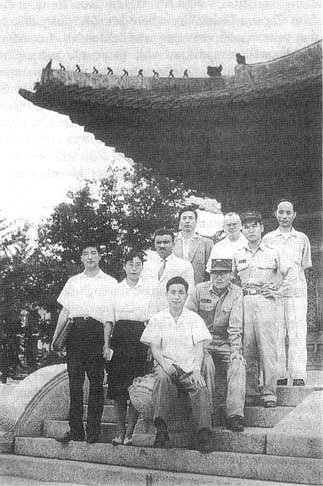 click for larger image Commemoration of the Martyrdom of the Bab, 1959The Bahá'ís of Seoul had an open air meeting in the historic Duk-soo Palace grounds, with prayers in two languages and an explanation of that special day. Front: Mr. Han Changgy, Miss Chee Hei Soon, and Mr. Chung Kwan Kuc. Middle: Mr. Maxwell, Capt. Kim Yong Kuen, and Capt. Im Pyong Mo. Rear: Mr. Kim Yong Yun, Mr. Roy MacDonald and Mr. Kim Chang-zin. Later in the year reports mentioned that other goal cities, Suwon and Songjongni, both had groups and rented Centers where they could hold meetings. In March of that year, 1959, the secretary of the Seoul Local Spiritual Assembly sent a report of twenty adult Bahá'ís, which included two women. In 1959 Mr. and Mrs. Son Chong Tae of Songjongni had the first Bahá'í marriage in Korea. He was a teacher in a high school and they were the only Bahá'ís in that city at the time. According to a report sent by Mr. McHenry, they moved into a poorly-heated room so they would be near to the place that was used as a Bahá'í Center. Mr. Rhee Yeun Sup, who was secretary of the Local Spiritual Assembly of Mokpo, wrote to the Bahá'í Geppo newsletter in Japan of a teaching trip to Koha Island. Mr. Smits had visited the island two years previously with some language school students and now he suggested that some Bahá'ís go there for teaching. Five went, including Mr. Smits. They walked all over the island praying, meeting people, talking to everyone about the Faith. When they left they estimated that half of the island (700) had heard about the Faith. The Bahá'ís promised to send literature and to visit regularly. By late 1962 there were thirty-six Bahá'ís on Koha Island and the Faith had spread to neighboring islands. The Summer School in Korea was now an institution. There was one in Kwangju the summer of 1959. Dr. Earl represented the National Spiritual Assembly of North East Asia. He also visited the Assemblies of Chunju and Mokpo. That year the Bahá'ís of Kwangju participated in the annual United Nations Day ceremony for the second consecutive year. It was an even
larger event than the previous year. It seems that the small Bahá'í community seldom missed a chance to proclaim the Faith. They wrote that the results of even meager efforts brought about "overpowering confirmations." The community in Seoul held what they said was perhaps their most successful public meeting to date. It took place at the Korean Government's Central Information Center and attended by 130 guests because it was advertised. Dr. David Earl was the principal speaker, with translation. The title of his speech was "The Coming World Civilization" and attracted much interest. There was only one woman present, a Bahá'í. The Local Spiritual Assembly secretary reported that the Bahá'í literature which was put out was "snapped up." In late 1958 Mr. Dale and Mrs. Barbara Enger and their two young sons came to Korea to pioneer, settling in Pusan. With their dedicated assistance the community was able to elect a Local Spiritual Assembly in April, 1960. It was the fifth city in Korea to have a Local Spiritual Assembly. The Auxiliary Board Member described how the Local Spiritual Assembly of Pusan was elected: "Trusting in Bahá'u'lláh, we were able to compile a voting list of twelve names; eight active, two inactive and two we had never met. On April 19 the political situation erupted and curfew was imposed effectively canceling our meeting scheduled for the next evening ... we attempted to contact all the voting members to reschedule the election for the 21st. But the Bahá'ís gathered spontaneously on the afternoon of the 20th. The Bahá'ís in the Army managed to have their ballots delivered on the 20th. We rescheduled the election for the morning of the 21st ... two Bahá'ís went to the wrong place and had to be fetched. However, by the Grace of Bahá'u'lláh we have our treasured Local Spiritual Assembly." Mr. Enger, who was the secretary, wrote a report of the activities some months before and after the election of the Assembly. The community had very structured activities. He told of the Sunday students' fireside with about five students attending regularly; an adult fireside with about four or five professors attending; a students' study class with about three students; an enrollment class of about three people, "one is ready"; a deepening class "held rather irregularly due to a series of weekend conferences." The special event that year was the observance of the Martyrdom of the Báb. Mr. Suh Byong In, chairman of the Assembly, was the speaker. His subject was "The Story of the Báb." Fifteen guests assembled for the observance. In 1962 the Engers left Korea to pioneer in Taiwan.
This was the program of the Summer School in Kwangju, 1960. The concern for deepening the Bahá'ís is apparent. [+CHAPTER10] 10. The Early 1960sIn April 1960 there were five Local Spiritual Assemblies: Seoul (first elected 1956); Kwangju (1956); Mokpo (1958); Chunju (1959); and Pusan (1960). There was a reported total of 75 Bahá'ís which included six pioneers: Mr. Smits, Mr. Maxwell, Mr. McHenry III, Mr. and Mrs. Enger and Sgt. Roy MacDonald.A report was sent to Hand of the Cause Miss Alexander in early 1960 telling of the teaching activities for several months. In April Mr. Kim Chang-zin went to Pusan from Suwon where he was then living. He spoke at one of Pusan's regularly scheduled meetings. The Board member described Mr. Kim's "humility, his gracious manner, his wide though unpretentious knowledge and his simple dignity." This man, who had waited for so many years to have contact with the Bahá'í community, made a deep and lasting impression on those who knew him.
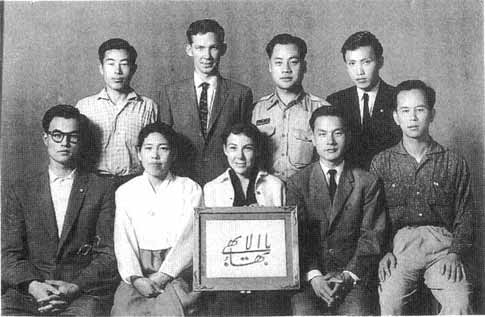 click for larger image The First Local Spiritual Assembly of the Bahá'ís of Pusan, elected 1960. Seated: Mr. Ko Han-joon (treasurer), Mrs. Lee Gap Sun, Mrs. Barbara Enger, Mr. Suh Byong-in (chairman) and Mr. Shin Yong-ho. Standing: Mr. Jun Yong-gap, Mr. Dale Enger (secretary), Mr. Kim Byung-ho and Mr. Oh Jung-yong. (When the present writer visited Korea in 1995 she was happy to meet Mrs. Lee who has been an active and steadfast promoter of the Faith through the years.) Members of a study class in the village of Yongsanri, Hanpyung-kun (Hanpyung county) in 1962. Mr. McHenry and Mr. Im Won Taek are at the right. Mr. Im had finished his education at Kwangju and returned to his native area to teach the Faith. Soon there were over 25 Bahá'ís and they formed the Local Spiritual Assembly of Haebo, which included this village.  click for larger image A Teaching Conference in Kyongju, December 29-30, 1962. The conference was opened by the mayor of the town visiting the newly acquired Bahá'í Center. There was such enthusiasm that nineteen adults and one youth enrolled in the Faith during this conference which was the culmination of weekend teaching during the last four months of the year.
 click for larger image A meeting in Kyongju, the ancient capital of the Silla Kingdom, October 21, 1962, celebrating the Birth of the Báb. Mr. Lee Yun-sup is translating for Mr. Maxwell. This meeting attracted about 40 people. Mr. Lee and Mr. Maxwell went to Kyongju for teaching every weekend during the last months of the year. A report written in early 1961 lists 97 believers, five Local Spiritual Assemblies (the same as elected in 1960), three groups and two isolated Bahá'ís. The next year, 1962, it was reported that Bahá'ís resided in 29 localities, including areas which had Local Assemblies. Teaching activity seemed to be widespread. Taegu now had more than 60 new believers. Praise was given to the youth for their teaching: Mr. Im Won Tack was a high school student who taught the Faith to his friends in the farm village of Chakungsung-mae; and Mr. Pak Chong-kyo, also under 21, "who worked hard to reestablish the LSA in Chunju". The development of the Local Spiritual Assembly in Iro on the island of Koha was assisted by Mr. Kim Chae-kwon. Mr. Ahm Chull Soon made several trips from Mokpo to help with the teaching. Ten Bahá'ís were listed in Chunju that year with half being women. A report sent to the National Spiritual Assembly stated that during a teaching conference in Kyongju twenty persons enrolled in the Faith, December 30, 1962: nineteen adults and one youth. It was the largest number of people to accept the Faith in one day. The conference was opened by the mayor of the city visiting the newly acquired Bahá'í Center. The conference and subsequent enrollments were the result of weekend teaching over the four months previous. An enrollment ceremony was conducted by Mr. Kim Chang-zin and Mr. Suh Byong Im on behalf of the National Teaching Committee. The report said "many of these new believers are important civic and cultural leaders in this city." The total number of Bahá'ís in Korea stood at 250, with some other figures mentioned: Hosa 9; Kaji 14; Koba 36. During the next few months as the mass teaching started these figures were to be exceeded. After 1962 it is difficult to give a complete, or more detailed, account of the progress of the Faith in Korea as it was growing in all directions. But perhaps it is interesting to mention that at that time the youth were becoming very active and much of the teaching was no longer in the hands of the pioneers. The three long-term pioneers, Maxwell, Smits and McHenry III, had been the primary teachers through the years. As they traveled with Korean Bahá'ís, the Koreans gained in knowledge and experience and became teachers on their own. It is also to be noted that, although some Korean women became Bahá'ís, they did not come into the Faith in the early days in the numbers that happened in some other countries. Perhaps a reason was that the pioneers and Koreans who traveled with them were all men. In 1953 at the beginning of the Ten Year Crusade there was only one Local Spiritual Assembly in North East Asia: Tokyo. By 1957, in addition to other areas in Asia, there were two Local Spiritual Assemblies in Korea: Seoul and Kwangju. By the end of the Ten Year Crusade,
Ridván 1963, there were twelve Local Spiritual Assemblies in Korea, which had been elected at Ridván the previous year: Seoul, Kwangju, Haebo, Iro, Kajo, Kochang, Mokpo, Namhae Is., Pusan, Samho, Suwon and Taegu. In the three months just preceding the end of the Ten Year Crusade, Hand of the Cause Dr. Rahmatu'llah Muhajir arrived in Korea and helped the community formulate a plan which had the objective of enrolling 1,000 believers in two months. The goal was exceeded during the first month and by Ridván, which was the end of the Crusade, 1,421 people had accepted the Faith. (Figures vary somewhat depending upon the reports as people were accepting the Faith every day in several areas.) Twenty-six Local Spiritual Assemblies were formed that Ridván, 1963; also there were five groups and 61 isolated believers. Dr. Muhajir visited Korea several times and was responsible for the community grasping the concept of mass conversion, or teaching and enrolling by groups. In January 1963 Mr. John McHenry III was appointed to the Auxiliary Board for Protection by the Hands of the Cause in Asia.
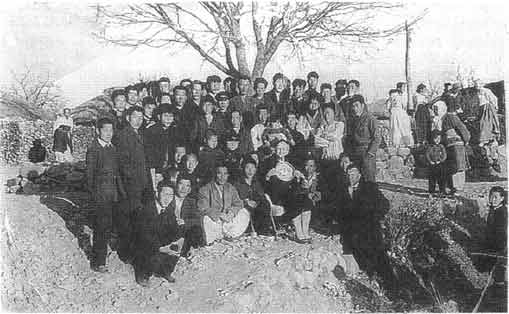 click for larger image Hand of the Cause Miss Alexander holding a plaque of the Greatest Name, surrounded by Bahá'ís of Kajo village in March 1963. At least three members of the Local Spiritual Assembly of Kajo can be seen in the photo. Mr. Maxwell is standing below to the right. The first Local Spiritual Assembly of the Bahá'ís of Taegu, 1963. Front: Miss Pak Ok Soon, Miss Chung Chong Jin, Miss Kim Chom Soo and Miss Chang Mal Hyang. Standing: Mr. Lee Yoon Sup, Mr. Kim Yong Tae, Mr. Dho Jae Kwon, Mr. William Maxwell and Mr. Pak Sam Bong. In November of the following year Miss Pak and Mr. John McHenry III were married.  click for larger image The first Local Spiritual Assembly of the Bahá'ís of Kajo Village, 1963. Unfortunately we do not have the names of these Bahá'ís. According to an article sent from the Bahá'ís in Korea to the Japanese Bahá'í News, Kajo was the first all-Bahá'í village in Korea, with a population of a little under 1000.
Hand of the Cause Agnes Alexander visited Korea in 1963. She wrote that she
received a phone call from Mr. Maxwell asking her to come for a few days. She
visited Kajo village, which, she wrote, had the privilege of being the first
Bahá'í village in Korea. She had a meeting with the women and
gave each of them a photo of the painting of 'Abdu'l-Bahá by Juliet
Thompson. She visited the Kyongju Bahá'í Center, the Pusan
Bahá'ís and returned to Seoul. She wrote that it was her fifth
visit to Korea. It was to be her last. That year Mr. and Mrs. Maxwell left Korea to return to the United States where he was to resume his education, receiving his doctorate. In late 1963 there was a report given by an Auxiliary Board Member which said that Korea had over 3000 Bahá'ís and the Faith was continuing to grow due to the steadfast, devoted and self-sacrificing efforts of the friends. The report gives an example: Mr. No Byong Ka of Kwangju walked nine days to reach the Summer School held in Taegu in August and he returned on foot. He wanted to bring back the spirit to his community in Kwangju. Teacher Training Institutes were being held at regular intervals; three so far in 1962/63. The teachers then went back to the villages to do mass teaching and consolidation. On December 10, Human Rights Day, the Faith was proclaimed on an international overseas broadcast, with Dr. David Earl speaking. A report states that it was the first public proclamation in several years. In preparation for the coming election of the first National Spiritual Assembly of the Bahá'ís of Korea, in 1963 a large committee of the most active Bahá'ís was appointed, called the National Administrative Committee, whose duty it was to assume the affairs of the Faith in Korea. The first appointment consisted of the four American pioneers then in Korea and nine Korean Bahá'ís. It prepared the community for the election the following year. The Faith in Korea was growing daily and the National Spiritual Assembly of North East Asia, based in Tokyo, could hardly keep up with the increasing changes. One decision of the new Administrative Committee was to officially start the Korean Wolbo newsletter. Mr. Yang Jae-ho was the editor of the
new Wolbo which was printed every Bahá'í month. At first it was four mimeographed pages. The committee wanted to print 500 copies but reduced this to 300 because of the expense. Although this was the first official Wolbo, back in 1956 there were two mimeographed editions of the Wolbo, one from Kwangju and the other from Seoul, printed for distribution among the friends. They contained deepenings, international news and local news. The Japanese Geppo newsletter had been sent to Korea as many people could read Japanese. In 1959 and 1960 there was reference to a Wolbo which Mr. Kim Chang-zin translated from Japanese; perhaps adding local news. He sent the manuscript to Mr. Yang Hyo Jong of Mokpo who printed and mailed it to Bahá'ís throughout Korea. By January 1960 issue #71 was sent out indicating that it had been issued for some time.
 At the London Congress, 1963. Mr. Kim Chang-zin (middle) was invited to attend by the National Spiritual Assembly of North East Asia as a representative from Korea. Others are from Japan: Auxiliary Board Member Mr. Michitoshi Zenimoto, and three members of the National Assembly, Dr. Ikuo Mizuno, Mr. Masazo Odani and Mrs. Barbara Sims. Mrs. Sims (the present writer) was a pioneer to Japan. Mr. Kim conversed with the friends from Japan in fluent Japanese. As the Faith continued to grow, teacher training institutes were started. This was one held in Seoul, in 1963. After attending the institute the teachers would go out to other areas to teach and deepen.  click for larger image After attending a Teaching Institute, the Bahá'ís went to Changchong village to spread the Faith. Here are some of the participants.[+CHAPTER11] 11. The First Annual Convention of the Bahá'ís of Korea, 1964In 1964 the first National Spiritual Assembly of the Bahá'ís of Korea was elected. The historic election took place in Taegu, April 22-25, 1964. At that time there were about 5000 Bahá'ís in the country. The number of delegates assigned to the Convention was 38, representing 26 Local Spiritual Assemblies which had been elected the Ridván before. (Some countries in those days elected delegates only from communities which had Local Spiritual Assemblies. As the overall Bahá'í community became more spread out delegates were elected from larger areas to include all the country.) Of the 38 delegates, 27 were able to attend the first convention. A total of 65 believers from 27 localities participated in the convention. The participants had the bounty of the presence of Hand of the Cause Dr. Rahmatu'llah Muhajir, who represented the Universal House of Justice. He presented a teaching plan for the newly elected National Spiritual Assembly to help them attain some of the teaching goals.The members of the newly-elected National Spiritual Assembly were Dr. David Earl (chairman), Mr. Suh Byong-in (vice-chairman), Mr. William Smits (corresponding secretary), Mrs. Joy Earl (treasurer), Mr. Pak Sam-bong (recording secretary), Mr. Kim Chang-zin, Mr. Kim Bong-chol, Mr. Yang Jae-ho and Dr. Kim Myung Jung. Korea was the first community to leave the jurisdiction of the National Spiritual Assembly of North East Asia. At the time of the election the Universal House of Justice gave some special tasks to the new National Spiritual Assembly to accomplish. The House of Justice wrote (in part), "We acclaim with joyful hearts the splendid response of so many devoted souls in Korea to the Message of Bahá'u'lláh, resulting in the formation of an independent Bahá'í Community and another pillar of the Universal House of Justice, an event of untold significance for Asia and the Far East. This Community, which first received the light of Bahá'u'lláh's revelation during the Ministry of the Centre of His Covenant, must now take up the tasks assigned to it in the Nine Year Plan." The Faith continued to grow, at an accelerated rate. There were three full-time Korean Bahá'í teachers and several part-time teachers and a number of teacher-training institutes, the first having been initiated in April 1963. After 1964 it becomes difficult to give a detailed statistical report. With the emphasis on teaching and with so many people devoting their efforts to spreading the Message of Bahá'u'lláh, enrollments in Korea soared. Consolidation was carefully considered and was assisted by the teachers returning again and again to the communities. In October 1964 Mrs. Ayako Ogi, one of the older Bahá'ís of Tokyo, visited Korea. In her early years, before she became a Bahá'í, she had lived
The first National Convention of the Bahá'ís of Korea, Taegu, 1964. Hand of the Cause Dr. Rahmatu'llah Muhajir, the official representative, is sitting in the middle. 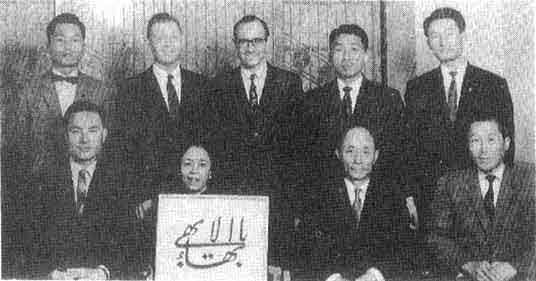 click for larger image The First National Spiritual Assembly of the Bahá'ís of Korea, elected 1964. Front: Mr. Suh Byong-in (vice-chairman), Mrs. Joy H. Earl (treasurer), Mr. Kim Chang-zin and Mr. Kim Bong-chol. Standing: Mr. Pak Sam-bong (recording secretary), Dr. David Earl (chairman), Mr. William Smits (corresponding secretary), Mr. Yang Jae-ho and Dr. Kim Myung Jung. 49 in Korea when it was under Japanese rule. It was the first visit of a Japanese Bahá'í to that country. While she was there she attended the sixth Teachers' Training Institute in Anyang and visited Bahá'ís in Taegu, Pusan, Kyongju, and Seoul and had one radio interview. Her non-Bahá'í relatives had been fearful for her safety because of the anti-Japanese sentiment in Korea. However, it was a successful teaching trip. When she returned to Japan the Asahi newspaper asked her to write of her trip. The following year, the second Japanese Bahá'í arrived in Korea to stay for two years: Mrs. Akiko Schreiber, whose husband Eugene had a position with an American company. In December 1964 Mr. Yang Jae-ho was appointed Auxiliary Board Member by the Hands of the Cause in Asia, the first Korean Bahá'í so appointed. There were now two Auxiliary Board Members: Mr. Yang and Mr. McHenry III, who had been appointed the previous year. Lt. Col. John and Mrs. Elizabeth McHenry, parents of John III, arrived in 1964 to stay for two years. Lt. Col. McHenry had visited Korea in the early 1950s and again in 1963 and marveled at the difference that a decade had made.
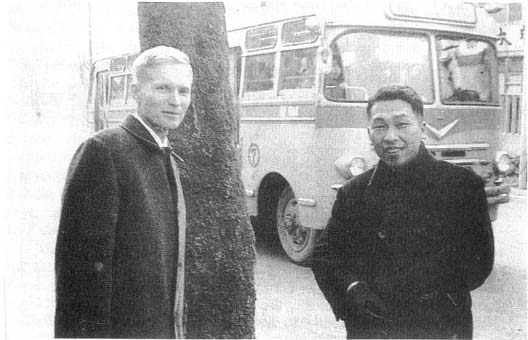 Two Auxiliary Board Members in Korea, 1965. Mr. John McHenry III and Mr. Yang Jae Ho, the first Korean to be appointed to the Auxiliary Board. Both were appointed by Hand of the Cause Miss Agnes Alexander. In 1969 Mr. McHenry was appointed the first Counsellor for Korea. [+CHAPTER12] 12. Later YearsIn 1965 the printing of Bahá'u'lláh and the New Era was accomplished. It was translated from the Japanese and Esperanto editions by Mr. Kim Chang-zin. He had started working on the translation in 1957 but as he could not work on it steadily it took him eight years.Also in 1965 a Certificate of Incorporation was issued by the government. The same year the National Spiritual Assembly acquired a National Hazíratu'l-Quds in Seoul, assisted by contributions from the National Spiritual Assemblies of Iran and North East Asia and donations from individual Bahá'ís.
 The National Hazíratu'l-Quds in Seoul in a photo taken soon after its acquisition in 1965. The acquisition was a goal of the Nine Year Plan (1964-1973). In 1966 Hand of the Cause Mr. Tarazullah Samandari visited Korea for nine days, accompanied by Mr. Ruhollah Mumtazi, a pioneer to Japan. Mr. Samandari met with the National Spiritual Assembly and gave "many useful ideas of teaching" according to a report. A report by Auxiliary Board Member Mr. Yang stated that Mr. Samandari visited seven localities, including Wolsong county, the mass-conversion area, and met 233 Bahá'ís and had publicity in three newspapers. Publications that year were two pamphlets, "Life After Death" and "Bahá'í Teachings of a World Faith." Mr. Kang Hyon-oh, chairman of the Masan Local Spiritual Assembly, passed away on October 12, 1966. He had opened the Bahá'í community of Masan which was able to elect an assembly in 1966. Auxiliary Board Member Yang called Mr. Kang "the most active teacher." Also in 1966 the first Korean Bahá'í Youth Conference was held in October at the Seoul Hazíratu'l-Quds, which had been purchased the year before. About 45 youth attended. According to a report, this conference was the beginning of youth activities throughout Korea.
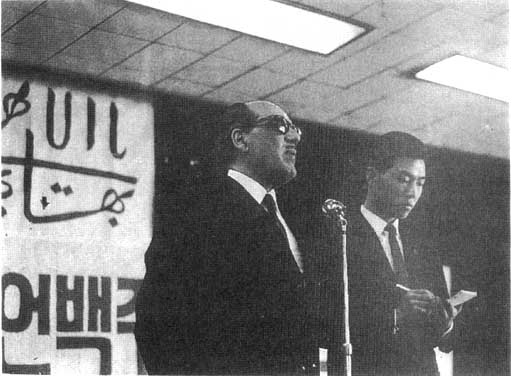 Hand of the Cause Mr. A.Q. Faizi is giving a speech during his visit to Korea in 1967. Mr. Cho Jin-yong is translating. Other Hands of the Cause to visit Korea were Mr. John Robarts in 1968, Mr. Ali Akbar Furutan in 1969 and Mr. Collis Featherstone in 1971, 1973 and at least one other time with his wife, Madge. In 1974 Hand of the Cause William Sears visited Korea with his wife, Marguerite. Hand of the Cause Amatul-Baha Ruhiyyih Khanum honored Korea with a visit in 1984.
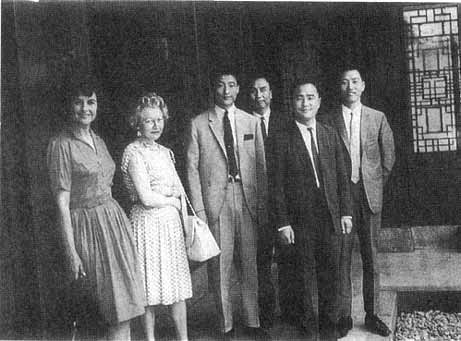 click for larger image The author, Mrs. Sims, far left, is shown during a visit to Korea in 1967. Next to her is Mrs. Elizabeth McHenry, (mother of Auxiliary Board Member John McHenry III), and other members of the National Spiritual Assembly. In 1970 a direct proclamation was presented to President Park Chung Hee. He wrote the Bahá'ís a cordial letter of acknowledgement. The government recognized the Bahá'í marriage and Holy Days in 1971. In 1971 the largest teaching conference to date was held in Seoul, with over 400 Bahá'ís attending. Almost half of the participants were from other countries and had just come from the North Pacific Oceanic Conference in Sapporo, Japan. The end of the Nine Year Plan given by the Universal House of Justice was 1973. According to a report in The Bahá'í World Vol. XV, all of the goals of the Plan related to expanding the Faith to three hundred localities and establishing one hundred Local Spiritual Assemblies were accomplished. Actually by Ridván 1973 the number of localities where Bahá'ís resided was 557, more than five times the number at the beginning of the Plan, and more than twice the number at Ridván 1968. A major accomplishment in 1976 was the establishment of the Bahá'í Publishing Trust of Korea. ln 1988 Dr. Kim Myung Jung was appointed Counsellor in Korea by the Universal House of Justice, the first Korean Bahá'í to be so honored.
 click for larger image Hand of the Cause Mr. Tarazu'llah Samandari visited Bahá'ís in seven locations and had publicity in three newspapers during his trip to Korea in 1966. Accompanying him was Mr. Ruhollah Mumtazi from Japan, standing fourth from the left. Standing next to Mr. Mumtazi is Mr. Eugene Schreiber who, with his Japanese wife Akiko, standing at the far right, was pioneering in Korea. This photo was taken in Seoul.
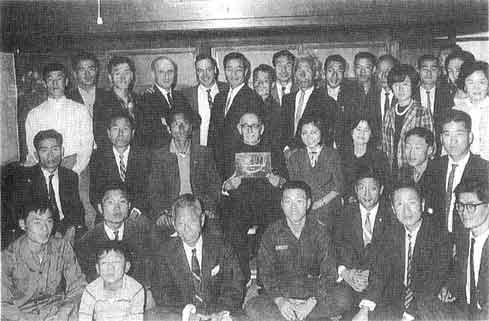 click for larger image Hand of the Cause Ali Akbar Furutan visited Korea in 1969. Shown here are Mr. Furutan, Counsellor Mr. Vic Samaniego from the Philippines, Auxiliary Board Member Mr. Yang Jae-ho, Mrs. Ridvaniyyih Suleimani, an Auxiliary Board Member in Taiwan and Mrs. Ok-sun McHenry at the Kyongju Bahá'í Center. 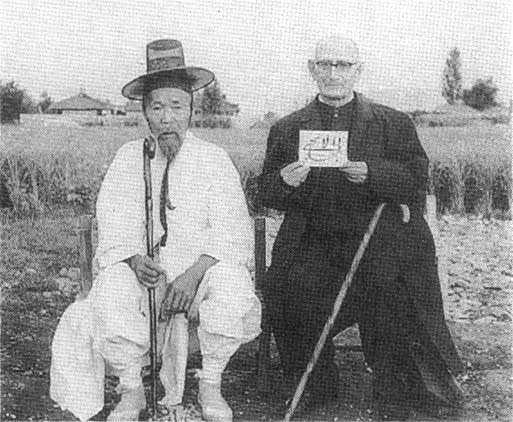 Hand of the Cause Mr. Samandari with a gentleman from Kyongju, who, unfortunately, was not identified.
 click for larger image 56 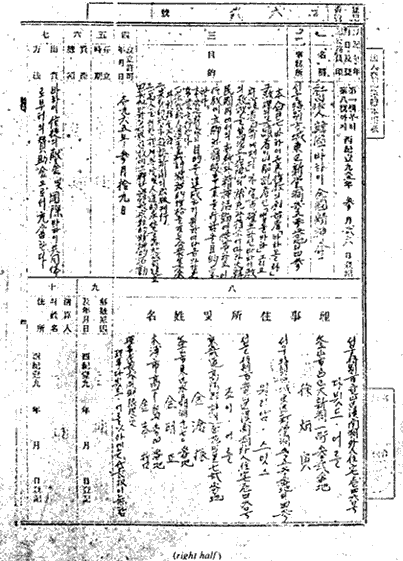 click for larger image A Certificate of Incorporation of the National Spiritual Assembly of the Bahá'ís of Korea dated March 19, 1965, issued by the government. The incorporation of the National Spiritual Assembly was a goal of the Nine Year Plan (1964-1973).
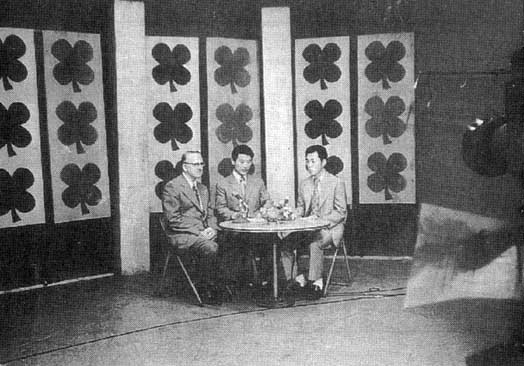 Hand of the Cause Collis Featherstone being interviewed on MBC Television in Taejun 1973. 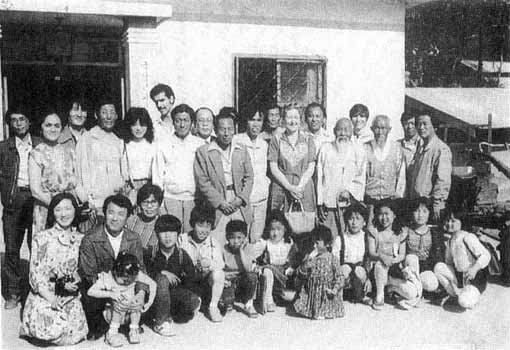 click for larger image In 1984 the Bahá'ís in Korea were honored by a visit from Hand of the Cause Amatul-Baha Ruhiyyih Khanum. She is shown here with Bahá'í friends on the island of Anja. Her travel companion Mrs. Violette Nakhjavani is standing on the left side. This was the largest conference in Korea up to that time. It was a post-conference held after the North Pacific Oceanic Conference in Sapporo, Japan, 1971. According to statistics, the Korean conference was attended by 302 Korean Bahá'ís and 163 Bahá'ís from foreign countries who included this conference on their way home from Japan. It was attended by Hand of the Cause Mr. Collis Featherstone. 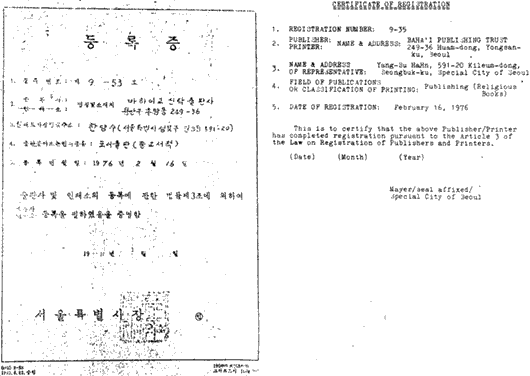 click for larger image Certificate of Registration of the Bahá'í Publishing Trust of Korea, with the translation into English; February 16, 1976. Afterword |
 |
start page (with chapter breaks) |
| METADATA | |
| Views | 67561 views since posted 2000; last edit 2025-01-28 14:58 UTC; previous at archive.org.../sims_raising_banner_korea; URLs changed in 2010, see archive.org.../bahai-library.org |
| Language | English |
| Permission | author |
| History | Scanned 2000 by Jonah Winters; Formatted 2000 by Jonah Winters; Proofread 2000 by Barbara R. Sims. |
| Share | Shortlink: bahai-library.com/410 Citation: ris/410 |
|
|
|
|
Home
search Author Adv. search Links |
|